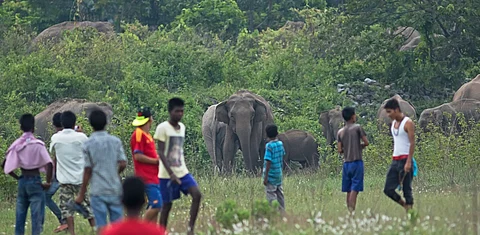

A paper published last month has offered several new insights into human-elephant conflict in north Chhattisgarh and its concomitant impact on losses suffered by farmers in the region.
The authors — Lakshminarayanan Natarajan, Parag Nigam and Bivash Pandav, from the Wildlife Institute of India, Dehradun — stated that the ongoing expansion of elephants into human-dominated areas with patchy forest cover in east-central India could be analogous to the paradigm of an ‘ecological trap’, with long-term negative impacts on elephant conservation.
Such expansion should thus be discouraged.
Management to increase elephant occupancy in relatively large and connected forest patches is imperative, they added, to minimise crop losses and improve elephant conservation.
Other recommendations made by the scientists to reduce negative human–elephant interactions in forest divisions include institutionalising elephant monitoring, transparent and prompt ex gratia payment for crop losses, and the use of portable physical barriers.
The Asian elephant (Elephas maximus) numbers 50,000 individuals in the wild. The species is the least numerous of the three extant Proboscideans.
These animals occur in 13 countries across Asia but India harbours more than 60 per cent of the global population.
“As a result of negative human–elephant interactions, > 500 human lives are lost annually, several hundred people are injured, and > 11 million ha of cultivated crops are affected. As agriculture and allied activities provide food, income and employment for nearly 61% of the rural populace, crop losses are a threat to livelihoods,” the paper noted.
Elephants usually forage on crops as they can offset scarcity of natural forage arising from habitat loss. Crops can compensate for nutritional deficiencies in elephants’ regular diet.
Crop foraging can also be a strategy used by bull elephants “to gain reproductive advantage through better expression of musth, which confers a competitive advantage in male-specific agonistic interactions”. Pachyderms usually feed at night to avoid confrontation with humans.
Elephants occurred historically in modern-day Chhattisgarh before going locally extinct during the 1920s and returning to the area from 1988 onwards.
Currently, 250-300 elephants are found in the state. According to the authors, they are a ‘metpopulation’ that has expanded its range from neighbouring Odisha and Jharkhand by ‘passive dispersal’ since 2000.
This means they have expanded en masse due to environmental factors like habitat saturation in their home ranges, rather than through ‘natal dispersal’, which is usually done by individual animals and driven by evolutionary motivators.
“Home ranges in Chhattisgarh are larger than in other areas in Asia as the elephants are distributed over fragmented habitats interspersed with human-use areas, where they exhibit extensive exploratory movements. Increasing human–elephant interactions in the state have been attributed to such exploratory dispersal. Although Chhattisgarh is a forest-rich state with extensive areas of potential elephant habitat, securing forest for long-term elephant conservation requires the development of effective conflict mitigation strategies,” the authors wrote.
The researchers analysed landscape-level crop loss in 10 forest divisions: Surguja, Surajpur, Balrampur, Jashpur, Manendragarh and Koriya administered under Surguja Forest Circle, and Katghora, Korba, Raigarh and Dharamjaigarh administered under Bilaspur Forest Circle. The landscape includes four protected areas: Guru Ghasidas National Park (1,411 sq km) and Tamor Pingla (543 sq km), Semarsot (430 sq km) and Badhalkol (104 sq km) Wildlife Sanctuaries.
They also assessed ‘fine-scale’ crop losses in a 1,200 sq km conflict hotspot at the intersection of Surguja, Surajpur and Balrampur Forest Divisions in Surguja Circle.
They also analysed crop loss records for 2015-2020 at the landscape level and for February 2019-February 2020 at the fine-scale level.
“We recorded 363 incidences of crop foraging by elephants from 60 villages and settlements in the intensive study area during February 2019-February 2020. The total area of crop loss from elephant incursions was 12.4 ha, comprising sugarcane, rice, maize, wheat, tomatoes, seasonal vegetables, mustard, green peas and local varieties of pulses. Loss of sugarcane was greatest (5.81 ha, 214 crop-loss days), followed by rice (3.50 ha, 64 crop loss-days), maize (1.73 ha, 23 crop loss-days) and wheat (0.68 ha, 42 crop loss-days). Losses of other crops were relatively minimal. The period of losses to cereals and maize mirrored the local crop cultivation cycles. Crop losses caused by elephant groups were higher than losses caused by solitary elephants,” the scientists found.
Crop losses caused by elephants were widespread across a 39,000 sq km of forest-agriculture mosaic, despite the state’s elephant population being relatively small.
These losses were higher in locations of intensive habitat use. This, said the researchers, was probably a result of both bulls and groups of female elephants foraging on crops in human-dominated areas, a situation less likely in relatively intact forest habitats, where female herds seldom forage on agricultural crops.
“Although the estimated effects indicated only a weak relationship with probability of crop loss by elephants, we urge caution when carrying out habitat improvement activities such as surface water augmentation in small forest patches, as these areas could become daytime refuges for elephants and hence perpetuate conflict,” wrote the experts.
They added that growing crops less palatable to elephants was not an option as the political economy and other complex socio-economic factors dictate farmers’ choice of crops.
“In economically disadvantaged districts affected by negative human–elephant interactions, switching to alternative crops could potentially affect the food security of local communities. Even if alternative crops are planted in patchy habitats, considering both the high mobility and generalist diet of elephants, conflict could simply be deflected to new areas,” as per the paper.
“As our research shows that areas with high crop losses are also areas that elephants use intensively, management to increase the time elephants spend within large and connected forest patches could be critical in the long term,” the paper concluded.
Human–elephant conflict in expanding Asian elephant range in east-central India: implications for conservation and management was published on January 17, 2025.